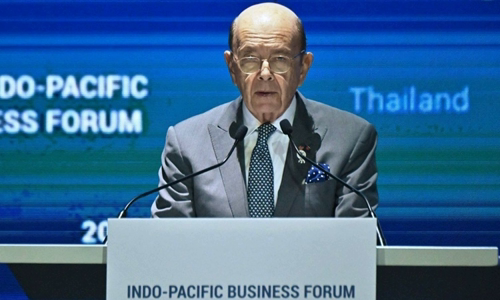The Green Point network was introduced by the United States against low quality infrastructure projects, leaving many countries in debt trap.
In an effort to find a counterweight solution to China's Belt and Road initiative, Washington recently announced its Green Point Network initiative to fund "sustainable" infrastructure projects.

US Secretary of Commerce Wilbur Ross addresses the Asia-Pacific Business Forum 2019 in Bangkok, Thailand, November 4. Photo: AFP
The plan is named after the book "Green Point Fence" by the late scientist Carl Sagan and is based on the image of the Earth taken from the Voyager 1 probe in space at a distance of 6.4 billion km.
The new initiative was initiated and led by the US Overseas Private Investment Agency (OPIC), the Japan Bank for International Cooperation (JBIC) and the Australian Ministry of Foreign Affairs and Trade (DFAT). US Secretary of Commerce Wilbur Ross announced the project on the sidelines of the 35th ASEAN Summit in Thailand on November 4.
An announcement on the OPIC website states that the aim of the Green Point Network is to increase cooperation between the public and private sectors, thereby "promoting reliable, high quality standards for developing global infrastructure in an open and comprehensive framework ".
The Green Point Network initiative is said to be an affirmation from the administration of President Donald Trump that helps to dispel doubts that the US is far from the region when the White House boss only sends national security adviser Robert O'Brien to attend the ASEAN annual meeting, the second year in a row to skip this event on the grounds of campaign schedule.
"We have no intention of giving up our military and geopolitical roles," Minister Ross told reporters.
O'Brien advises that the Green Point Network initiative will counter the tendency of "poor quality" projects that have led many countries into debt traps, referring to Washington's complaints about projects. supported by the Belt and Road initiative, which they think is disrupting sovereignty as well as the financial stability of the countries concerned.
The United States is not the only country that has expressed concern about China's infrastructure investment fund. Other countries consider the Belt and Road an integral part of Beijing's "debt-trap diplomacy" policy, when it has repeatedly requested concessions or demanded benefits from countries it cannot follow. timely repayment schedule.
For example, in 2017, Sri Lanka was forced to hand over control of the Hambantota port to China so that Beijing erased them a debt worth about one billion dollars.
Minister Ross noted that the Green Point Network is in its early stages but will include countries committed to "developing sustainable infrastructure".
According to experts, the move is part of the Trump administration's foreign policy vision focusing on a "free and open" Indo-Pacific region ", launched by the US President in attend the ASEAN summit in Manila, Philippines, 2017.
Responding to the US-led Green Point Network initiative, in a commentary posted yesterday, the Chinese Communist Party's Global Times newspaper called it a new means for the US to generate larger "numbers." "and reap the benefits. But according to author Shi Tian, it should not be used for the purpose of hindering China as well as hindering cooperation between Beijing and other countries in the region.
"If Washington wants this plan to succeed, they need to deliver more than words and be more sincere. They should give up the 'zero-sum game' thinking and focus on the results. "China is waiting for the US to prove its seriousness, so do the other Asia-Pacific countries", the author emphasized.
It is not clear how effective the Washington-backed initiative will be in curbing Belt and Road development projects. Green Point Network organizers say the initiative will act as a catalyst for personal finance but has no lending function, in contrast to the Belt and Road initiative.
According to the Asian Strength Index, published by the Lowy Institute in Sydney, Australia, in 2019, the United States is still a major power involved in regional issues but "does not perform as expected" by expansion. Chinese influence.
"The United States remains an important participant but not the main economic power in Asia," said Herve Lemahieu, head of the Lowy Institute's Asian Diplomacy and Power Program. "They have to get used to it."



 LoveDie
LoveDie







